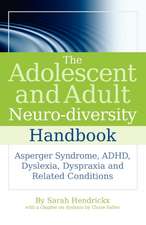Differential Diagnosis of Movement Disorders in Clinical Practice
Autor Abdul Qayyum Rana, Peter Hederaen Limba Engleză Paperback – 15 oct 2013
This book is divided into five chapters covering the common phenomenology of movement disorders and includes tremor, dystonia, chorea, myoclonus, and tics. The etiology, pathophysiology, symptoms and treatments of these conditions are briefly reviewed, with the emphasis on the most common practical challenges encountered with these patients.
Differential Diagnosis of Movement Disorders in Clinical Practice is aimed at postgraduates training in neurology, emergency care physicians, internists and primary care providers. Medical students will also find this book particularly helpful during their neurology rotations.
Preț: 357.61 lei
Preț vechi: 376.43 lei
-5% Nou
Puncte Express: 536
Preț estimativ în valută:
68.44€ • 71.04$ • 57.06£
68.44€ • 71.04$ • 57.06£
Carte tipărită la comandă
Livrare economică 25 martie-08 aprilie
Preluare comenzi: 021 569.72.76
Specificații
ISBN-13: 9783319016061
ISBN-10: 3319016067
Pagini: 102
Ilustrații: IX, 112 p. 8 illus.
Dimensiuni: 127 x 203 x 20 mm
Greutate: 0.14 kg
Ediția:2014
Editura: Springer International Publishing
Colecția Springer
Locul publicării:Cham, Switzerland
ISBN-10: 3319016067
Pagini: 102
Ilustrații: IX, 112 p. 8 illus.
Dimensiuni: 127 x 203 x 20 mm
Greutate: 0.14 kg
Ediția:2014
Editura: Springer International Publishing
Colecția Springer
Locul publicării:Cham, Switzerland
Public țintă
Professional/practitionerCuprins
Tremor.- Dystonia.- Chorea.- Tics.- Myoclonus.
Notă biografică
Abdul Q. Rana, MD, FRCPC, Consultant Neurologist and Director, Parkinson’s Clinic of Eastern Toronto & Movement Disorders Centre, Toronto, Ontario, Canada
Dr Rana is author of two other Springer books: Neurological Emergencies in Clinical Practice and Neuroradiology in Clinical Practice.
Peter Hedera, MD, PhD, Associate Professor, Department of Neurology, Division of Movement Disorders, Vanderbilt University, Nashville, TN, USA
Dr Rana is author of two other Springer books: Neurological Emergencies in Clinical Practice and Neuroradiology in Clinical Practice.
Peter Hedera, MD, PhD, Associate Professor, Department of Neurology, Division of Movement Disorders, Vanderbilt University, Nashville, TN, USA
Textul de pe ultima copertă
This practical, pocket-sized, quick reference book is for those who need to manage movement disorder patients without the immediate help of a movement disorder neurologist. Only the most pertinent information is covered.
This book is divided into five chapters covering the common phenomenology of movement disorders and includes tremor, dystonia, chorea, myoclonus, and tics. The etiology, pathophysiology, symptoms and treatments of these conditions are briefly reviewed, with the emphasis on the most common practical challenges encountered with these patients.
Differential Diagnosis of Movement Disorders in Clinical Practice is aimed at postgraduates training in neurology, emergency care physicians, internists and primary care providers. Medical students will also find this book particularly helpful during their neurology rotations.
This book is divided into five chapters covering the common phenomenology of movement disorders and includes tremor, dystonia, chorea, myoclonus, and tics. The etiology, pathophysiology, symptoms and treatments of these conditions are briefly reviewed, with the emphasis on the most common practical challenges encountered with these patients.
Differential Diagnosis of Movement Disorders in Clinical Practice is aimed at postgraduates training in neurology, emergency care physicians, internists and primary care providers. Medical students will also find this book particularly helpful during their neurology rotations.
Caracteristici
Basic and well organized information for differential diagnosis and management of most common movement disorders Can be used without comprehensive knowledge of the discipline of movement disorders as a bedside tool Covers most important aspects of movement disorder diagnosis and management, and only most pertinent information is included Assists the reader in quickly and easily recognizing the main problems that need to be addressed in movement disorder patients













